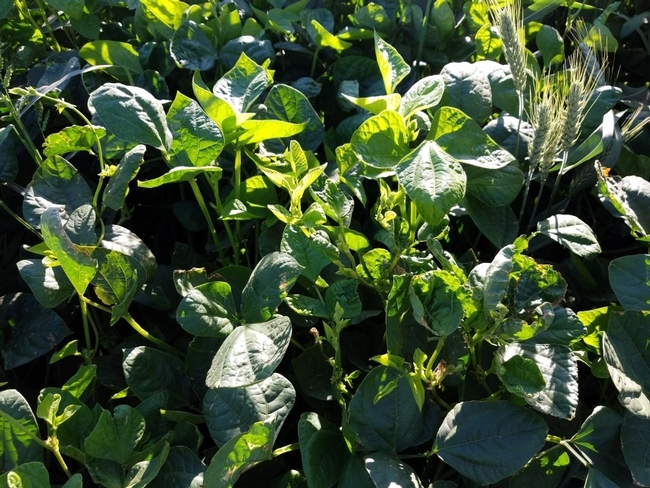We are getting prepared for our second year of a three-year project evaluating a warm-season legume cover crop between winter small grain crops. We are conducting the trial in a commercial field on Staten Island in the Delta. We are comparing soil health characteristics, greenhouse gas emissions, and grain yields between the cover crop treatment and the standard dry fallow. While cover cropping, particularly in the warm-season, is not a typical management practice in the annual crop rotations of the Delta, it is a management practice identified in the Healthy Soils Program of the California Department of Food and Agriculture as having the potential to improve soil health, sequester carbon, and reduce greenhouse gas emissions. This article describes the soil results from the first year of cover cropping (2018 season).
Methods: The trial is a randomized complete block design (approximately 4.5 acres) with three replicates of each treatment. The soil type across the trial is a Valdez silt loam. Baseline soil samples were collected in July 2018 following wheat harvest but prior to tillage. Soil was sampled from 0-6, 6-12, 12-24, and 24-36 inch depths. On July 30, 2018, a cowpea cover crop (Vigna unguiculata cv. ‘Red Ripper', Figure 1) was inoculated with Rhizobium and planted after a pre-irrigation. Pre-irrigation was only applied to the cover crop plots. The cover crop was drill-seeded at 7-in row spacing with a planting density of approximately 50 pounds of seed per acre. A second irrigation was applied approximately one month after planting. End-of-season soil sampling (0-6 and 6-12 inch depths) occurred on October 23, 2018, prior to cover crop termination. Soil properties of interest include bulk density, soil moisture, salinity, pH, total nitrogen (N), and total carbon (C). Soil properties were analyzed by the following methods: pH from the soil saturated paste, salinity by the saturated paste extract, and total N and C by combustion method.
Preliminary Results: Soil properties are presented for the baseline condition (Table 1) and for the end of the first cover cropping season (Table 2). Bulk density averaged 1.0 g/cm3 across sample timings, depths, and treatments. Soil moisture (% by volume) was observed to increase from the baseline condition in the cover crop (“CC”) treatment. At baseline sampling, salinity increased with depth from 0.47 to 2.44 dS/m. After one cover cropping season, salinity increased in both treatments, but increased more in the no cover crop (“No CC”) treatment, averaging 1.22 dS/m from 0 to 12 inches. Soil was acidic, which is typical for the region. The pH averaged 5.5 across sample timings, depths, and treatments, but there may be a trend for cover cropping to increase the pH. Total N and C decreased with depth at the baseline sampling. After one cover cropping season, there was little change from the baseline condition in both treatments.

Summary: The Delta is a unique agricultural region with unique environmental challenges. Some soils in the region are subsided due to oxidation of organic matter, and some soils suffer from salinity, having limited ability to leach salts due to low permeability soils and shallow groundwater. Cover cropping is not a typical practice in the annual crop rotations of the region, and summer cover cropping is particularly rare. After the first year of a three-year study, cover cropping had no observed effect on bulk density, Total N, and Total C. Cover cropping may have slightly raised the pH in the top 12 inches, compared to dry fallow. The cover crop treatment, having received two irrigations, had lower salinity in the upper layers of soil compared to dry fallow. We also observed that the 2018-2019 triticale crop that was planted in the field germinated roughly five days earlier in the cover crop plots compared to the fallowed plots. Thus, it appears that summer cover cropping with a legume has the potential to improve soil tilth at a time of year when the field would otherwise be fallowed and dry with no soil cover, and there could be agronomic benefits to subsequent crops. We will continue to monitor these soil properties in 2019 and 2020, and additionally, we will monitor small grain yields and greenhouse gas (CH4, N2O) emissions.
We would like to thank Dawit Zeleke and Morgan Johnson (Staten Island), Tom Johnson (Kamprath Seed), and Margaret Smither-Kopperl and Valerie Bullard (USDA-NRCS) for their cooperation on this trial. We would like to acknowledge the California Climate Investments program for funding, and our UC colleagues who are cooperating on this grant in other parts of the state (Jeff Mitchell, Will Horwath, Veronica Romero, Sarah Light, Amber Vinchesi-Vahl, and Scott Stoddard).
Survey: We would also like to alert readers of a cover cropping survey that is being conducted by the Contra Costa County Resource Conservation District. The survey is found here. The purpose of the survey is to learn more about cover cropping practices and barriers to adopting cover cropping on-farm. Even if you farm in another county, please consider filling out the survey, which should take about 10 minutes. The survey is open through the end of June. Your responses will help inform CCC RCD and UCCE programming. Thank you for your participation.
This article originally posted in the SJC and Delta Field Crops blog.

